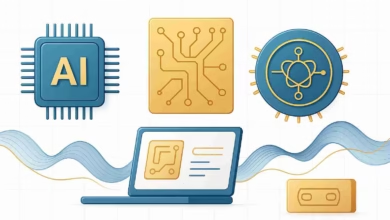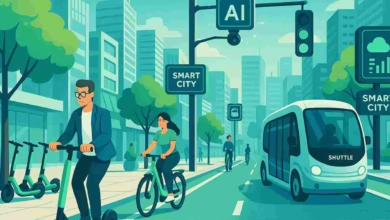AI-Powered Cybersecurity: What Computex 2025 Reveals About the Future of Digital Defense – BytesWall

TAIPEI, Taiwan – The tech world is gathered at Computex 2025, where the main exhibition kicked off today, May 20, 2025, at the Taipei Nangang Exhibition Center. Amid the buzz of AI innovations, one trend stands out: the integration of AI into cybersecurity. As cyberattacks grow more sophisticated—global cybercrime costs are projected to hit $13.8 trillion by 2028, according to Cybersecurity Ventures—AI-powered tools are stepping up to protect businesses and consumers alike. BytesWall Media Team explores how Computex 2025 is showcasing the next generation of digital defense and what it means for the future.
AI-Powered Cybersecurity Takes Center Stage
At Computex 2025, cybersecurity is getting a major AI boost. GIGABYTE, known for its Jetson Orin-based systems, unveiled an AI-driven intelligent surveillance platform on Day 0 that uses real-time threat detection to identify potential breaches. The system, showcased at their booth today, can analyze network traffic 40% faster than traditional methods, flagging anomalies like ransomware attempts in seconds.
Meanwhile, NVIDIA’s edge AI solutions, introduced during Jensen Huang’s keynote, are being adapted for cybersecurity applications. Their Isaac GR00T platform, which focuses on robotics, also supports AI models for predictive analytics in digital defense, helping businesses anticipate threats before they strike. “AI is rewriting the rules of cybersecurity,” Huang noted during a press briefing, emphasizing the need for proactive solutions in an increasingly connected world.
Real-World Applications: How AI Is Making a Difference
1. Real-Time Threat Detection
AI’s ability to process vast amounts of data in real time is transforming cybersecurity. At Computex, Advantech showcased an AI-powered firewall that uses machine learning to detect and block phishing attacks with 98% accuracy. A small retail chain in Singapore, an early adopter, reported a 60% drop in successful phishing attempts since implementing the tool, saving an estimated $50,000 in potential losses.
2. Predictive Analytics for Proactive Defense
Predictive analytics is another area where AI shines. Taiwantrade.com, at booth Q0930, highlighted an AI-driven cybersecurity tool that analyzes historical data to predict future threats. For example, a logistics company in Taiwan used the tool to identify a vulnerability in its supply chain software, patching it before hackers could exploit it. This kind of foresight is becoming essential as cyber threats evolve.
3. Automating Incident Response
AI is also automating incident response, reducing the burden on IT teams. A startup at Computex’s InnoVEX pavilion, CyberShield AI from France, demoed a tool that automatically isolates compromised devices and deploys patches within minutes of detecting a breach. “It’s like having a 24/7 security guard,” said the founder, noting that their clients have cut response times by 70%.
The Numbers Behind the Trend
The stakes are high in cybersecurity, and AI is proving its worth. A 2025 report by Gartner predicts that 80% of enterprises will use AI-powered cybersecurity tools by 2027, up from 30% in 2023. Adoption is driven by necessity: the average cost of a data breach in 2025 is $4.5 million, per IBM, and AI tools can reduce this cost by up to 20% through faster detection and response.
At Computex, the focus on cybersecurity aligns with broader trends. With 60% of the event’s 4,800 booths dedicated to AI-driven technologies, as noted by TAITRA Chairman James Huang, it’s no surprise that digital defense is a priority.
Challenges and Ethical Concerns
AI in cybersecurity isn’t without risks. False positives can overwhelm IT teams—Advantech’s firewall, for instance, flagged 5% of legitimate traffic as suspicious in early tests. There’s also the ethical concern of AI being weaponized by hackers; generative AI tools can create convincing phishing emails, making attacks harder to detect.
Privacy is another issue. AI cybersecurity tools often require access to sensitive data, raising questions about compliance with regulations like GDPR. “Businesses need to balance security with privacy,” warns cybersecurity expert David Lin. “Transparency is key to building trust.”
What’s Next for AI in Cybersecurity
Computex 2025 is a glimpse into the future of digital defense. As AI continues to evolve, we can expect more advanced threat detection, smarter automation, and even AI-to-AI battles between defenders and attackers. For businesses, the takeaway is clear: investing in AI-powered cybersecurity isn’t optional—it’s a necessity. For consumers, these tools promise a safer digital experience, from secure online shopping to protected personal data.
The innovations at Computex are just the beginning. As the event continues, BytesWall will keep you updated on how AI is shaping not just cybersecurity, but the entire tech landscape.
Stay informed on the latest tech trends! Follow BytesWall’s Computex 2025 live updates for more insights and innovations.
Sources
- Cybersecurity Ventures 2025 Report
- Gartner 2025 Cybersecurity Trends
- IBM 2025 Cost of a Data Breach Report
- Official Computex 2025 Website
- X posts from cybersecurity experts



